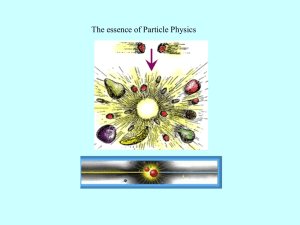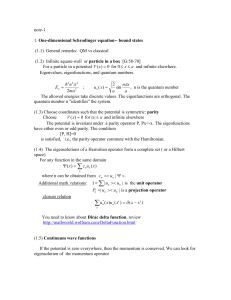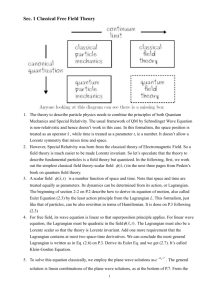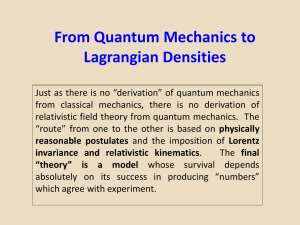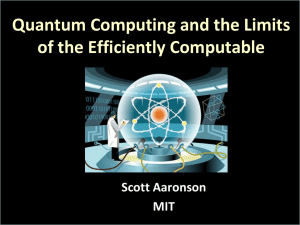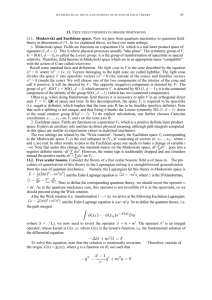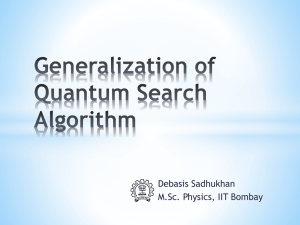Document
advertisement
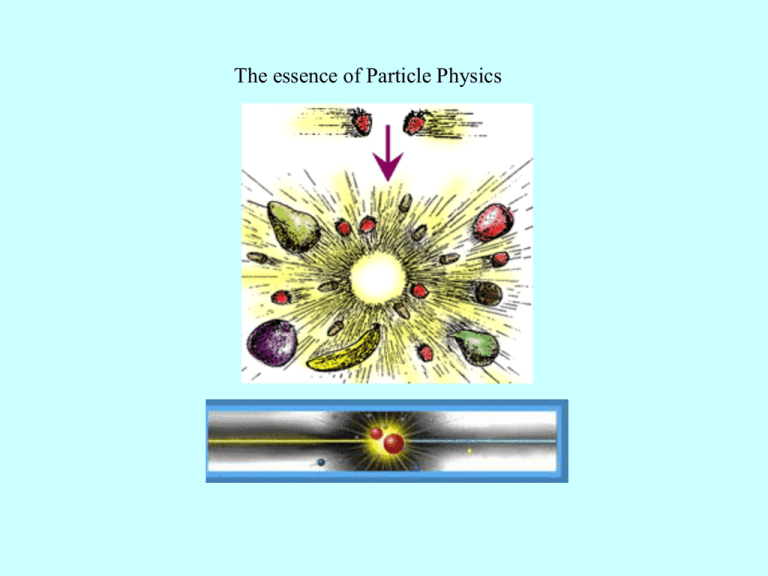
The essence of Particle Physics The essence of Particle Physics Particles are actually not like balls but essentially more fields! Well, not quite. They are quantized fields. Fields when quantized are not like fields but more like particles. Quantum Field Theory Field Theory x, t j ( xm ) Space and time are treated equally as parameters. It is manifestly Lorentz Invariant. Quantum Field Theory x ˆx For a quantum theory of field, the field is promoted to operators! It is still manifestly Lorentz Invariant. Particle Quantum Mechanics x(t ) xˆ (t ) Space is operator while time remains a number parameter. 場的觀念原來是來自一個粒子系統的連續極限! y ri (t ) yi (t ) i 1 N 粒子排列整齊,編號自然以平衡時的水平位置最自然! 當粒子間隔區向無限小,離散足標趨向連續變數: ix yi (t ) y( x, t ) 這只是一個比喻。 因為場並不必然需要有粒子系統的存在,例如電場。 Classical Field Theory x, t x It is just like electric field but simpler, as a scalar not a vector. ϕ is a scalar not a vector as electric field: E It is easiest to describe fields using Lagrangian and Hamiltonian. Action is defined as the integral over time of the Lagrangian. The equation of motion is given by the principle of Least Action. For fields, the Lagrangian would be the integral over space of a Lagrangian Density L : The integration is Lorenz Invariant. The Lorenz invariance of the Lagrangian density will guarantee the Lorenz invariance of Action and hence EOM. The equation of motion is given by the principle of Least Action. f ( x ) ® f ( x ) + df ( x) Euler Equation 尋找 ϕ 的線性運動方程式,L 必須由場及其一次微分的平方組成 若再要求Lagrangian是Lorenz Invariant,以下為唯一可能: Klein-Gordon Equation Hamiltonian Formalism For Fields: ¶L pi = ¶qi H º å pi qi - L i = d 3x H º å pi qi - L i Conjugate Momentum For Klein-Gordon Fields: x L x δ t Solving KG Equation: Expand the KG field in terms of Fourier Series Plug into KG Eq.: Every Fourier Component behaves like a SHO with ω p Ep 2 p m2 KG Field is just a collection of SHO’s. Each SHO is characterized by its k or p “momentum”. The frequency ω or “energy” of the SHO is just that of a relativistic particle with mass m. 物體的變形可以被分類為一個一個特定的模式 Norm! 每一個模式都是一個簡諧運動 一個簡諧運動,有一個內在的特定的振動頻率! 每一個模式,對應一個內在的特定的振動頻率! 不同模式頻率不同 物體的變形就是以以上模式或其疊加來進行! 這就是場: These SHO’s correspond to the plane wave solutions of KG Eq. e iEtip x or e iEtip x A general solution is a linear superposition of all plane waves. 3 d p d p iEtip x iEtip x ( x) a p e c p e 3 3 2 2 3 3 d p d p' iEtip x iEtip ' x a p e 3 c p ' e 3 23 2 3 d p d p' + iEt-ip'×x -iEt+ip×x =ò a ×e +ò b ×e ) ) 3( p 3 ( p' ( 2p ) ( 2p ) 3 = ò d3p ( 2p ) -ip×x + ip×x a × e + b × e ) p 3( p p' p The solution of KG Equation: f ( x) = ò d3 p ( 2p ) -ip×x + ip×x a × e + b × e ) p 3( p d p iEtip x iEtip x x a p e bp e 3 2 3 For real field: bp ap The real solution of KG Equation: f ( x) = ò d3 p ( 2p ) -ip×x + ip×x a × e + a × e ) p 3( p Ep 2 p m2 Dirac Notation 狀態 Ket 所有狀態組成一向量空間 Bra 此向量空間的 Dual 空間 測量 測量期望值 算子 ( Oˆ Oˆ ) ( ) Oˆ = Y Oˆ Y = Y Oˆ + Y = Y Oˆ Y Oˆ 與 內積 那些物理量是確定的? 確定的物理量 O 算子化為數 Oˆ o 作用於測量結果確定的狀態,算子的效果與數一樣,數 o 就是確 定的測量結果。 測量一個物理量時的不確定性是由測量結果的標準差或稱統計漲落來描述 : Oˆ Oˆ 2 Oˆ 2 Oˆ Oˆ 2 Oˆ 2 o 2 o 2 2 2 o2 o2 0 Oˆ o 本徵函數 Eigenfunction 本徵值 Eigenvalue 動量的本徵函數 pˆ p 波狀的態,動量完全確定 xˆ pˆ p p p x 位置的本徵函數 x 粒子狀的態,位置完全確定 能量的本徵態 E E xˆ x x x 線性代數的計算與基底的選擇無關 Dirac Notation 就是再強調這個事實 波函數 (x ) 就是以 x 為基底表示的向量分量! 你一樣可以選擇其他基底例如: p 狀態 波函數 ( x) x * ( x) x Bra 測量 測量期望值 算子 ˆ ( x) O Oˆ Oˆ Oˆ Oˆ Oˆ 與 Oˆ * ( x) Oˆ ( x)dx 內積 量子世界的兩類物理實體 狀態 波函數 測量 算子 (x ) Oˆ 測量期望值 Oˆ * ( x) Oˆ ( x)dx 古典世界中以上兩類物理實體是合而為一 由狀態決定 粒子未來的 測量結果。 狀態 粒子的狀態可由可測量物理量惟一地標定 數值(函數) x(t ), p(t ) 測量 量子力學的原則 pˆ i x xˆ x 一個古典物理的數字物理量在量子力學中對應於 一個作用在波函數上的運算動作! 這些運算動作將代表狀態的波函數映射到另一個波函數! x Oˆ ˆ x O * 而這個物理量測量的期望值可以計算: Oˆ ( x) Oˆ ( x)dx 算子 Operaor 測量結果確定的狀態 測量並非永遠都是不確定。 對於自由粒子,動量是確定的(因為守恆)(但位置測量不確定): p 0 ei ( kxt ) p k 動量算子作用於自由粒子波函數,效果和乘上一個數 hk 相同: pˆ p ( x, t ) pi p ( x,t )0 ei kxt kp pp ( x, t ) x pˆ p 作用於測量結果確定的狀態,算子的效果與數一樣, 此數就是確定的測量結果。 能量的本徵態 能量算子: f ( x, p) f x,i x 2 2 2 ˆ p ˆ 2 V ( xˆ ) H V ( xˆ ) 2m 2m x Hˆ E 2 2 2 ( x) V ( xˆ ) ( x) E ( x) 2m x d 2 2m 2 V ( x) E 與時間無關的薛丁格方程式 2 dx 算子與數最大的不同就是算子沒有交換性: xˆ pˆ pˆ xˆ x ˆ ˆ p x i x i x i xˆ pˆ x x x xˆ pˆ pˆ xˆ xˆ, pˆ i 0 xˆ, pˆ i Canonical Commutation Relation 兩個物理量能否同時精確測量,由它們是否可交換決定! xˆ pˆ pˆ xˆ xˆ, pˆ i 0 電子的動量與位置不能同時測準! Oˆ , Oˆ Oˆ Oˆ Oˆ Oˆ 0 Oˆ , Oˆ Oˆ Oˆ Oˆ Oˆ 0 這兩物理量不能同時測量。 這兩物理量能同時測量。 1 2 1 2 2 1 Lˆ , Lˆ Lˆ Lˆ Lˆ Lˆ 0 x z x z z x 1 2 1 2 2 1 Lˆ , Lˆ Lˆ Lˆ Lˆ Lˆ 0 2 2 z 2 z z Now! Quantum Field Theory We use Canonical Quantization to go from mechanics to quantum mechanics: Upgrade all observable to operators and impose a commutation relation between position and momentum: Fields grow out of systems of particles y ri (t ) yi (t ) i 1 N 當粒子間隔區向無限小,離散足標趨向連續變數: ix yi (t ) y( x, t ) Space coordinates x are actually indices! We know how to quantize particle system and hence we know how to quantize fields! Upgrade all observables to operators and impose a commutation relation between fields and their momenta: qi qˆi x ˆx ix ( 3) ( x, t ), y, t i ( x y), ( x, t ), y, t ( x, t ), y, t 0 Quantum Field Theory is done! x ˆx a, b aˆ, bˆ fˆ ( x ) = ò ( ( 2p ) d3 p 3 aˆ p × e-ip×x + bˆp+ × eip×x ) What is the commutation relation of the a operators? KG Field is just a collection of SHO’s. Hint from Quantum SHO: a a q 2 fˆ ( x ) = ò d3 p ( 2p ) 3 ( aˆ p × e-ip×x + aˆ +p × eip×x ) a a p i 2 Reasonable Guess: SHO of different p are decoupled and hence their operators commute. fˆ ( x ) = ò d3p 2w P ( 2p ) 3 ( aˆ p ×e -ip×x + p + aˆ × e ip×x ) fˆ ( y) = ò d3p 2w P ( 2p ) 3 ( aˆ -ip×y + ip×y ˆ × e + a × e ) p p a a q 2 a a p i 2 AB, C ABC CAB AB, C A, CB H E =E E The operator a+ can be used to raise the energy by one quantum while the operator a can be used to lower the energy by one quantum The operator a+ is called Raising Operator while the operator a Lowering Operator. Quantum Field Theory is just a series of quantum SHO. The operator ap+ can be used to raise the energy by one quantum ωp while the operator ap can be used to lower the energy by ωp. There is a conserved momentum. The operator ap+ can be used to raise the momentum by one quantum p while the operator ap can be used to lower the energy by p. 量子彈簧的行為非常類似數目可改變的一種粒子 粒子最重要的就是不可分割性 量子彈簧最適合描述不可分割的基本粒子 fˆ ( x ) = ò d3p 2w P ( 2p ) a n p 3 ( aˆ p × e-ip×x + aˆ +p × eip×x ) 0 p, n H p, n nEp p, n P p, n np p, n Particle space are built. ap+ Creation operator and ap Annihilation operator of a particle with momentum p and energy Ep Dirac field and Lagrangian The Dirac wavefunction is actually a field, though unobservable! Dirac eq. can be derived from the following Lagrangian. L L L i m i m i m 0 i m 0 i m 0 i m 0 Negative energy! Anti-commutator! A creation operator! ~ ~ b b, b b b annihilate an antiparticle! a , a 0 a a p p a p a p 0 a p 0 p Exclusion Principle p p p a a p
